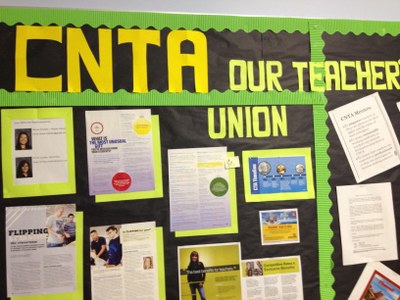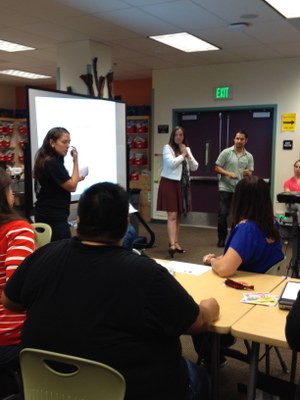Project 3: Camino Nuevo Teacher's Association (CNTA) Site Representative
Overview
Ten years ago, Camino Nuevo teachers organized a union and over the past decade educators have bargained a significant number of contractual gains such as a set pay scale, extensive and comprehensive health benefits, and defined work hours. In my second year as the Sandra Cisneros CNTA Site Representative, I worked to transition our teachers to mandatory agency fees, addressed specific site teacher needs, and helped the president of the union in developing bargaining ideas and strategies to negotiate teacher compensation. The union at my school site is very strong and works collaboratively with the principal to bring about positive change for teachers, staff and students. After each site meeting I, along with the other site representative, and a teacher from staff meet with the principal to work together in order to address teacher needs, possible solutions and next steps.
Main Activities
Over the course of the 2013-2014 school year, I planned and led three school-site union meetings with teachers and attended three Camino-wide CNTA leadership meetings.
The following list are the school-site meetings that we held including a list of discussed agenda items:
- SCLA Site Meeting #1: Check-in, Bargaining Agreement, Agency Fees, Celebrations/Concerns/Questions
- SCLA Site Meeting #2: Agency Fees, Bargaining, Site Celebrations, Check-in with Principal, Inclusion Model Training, Release Days, Celebrations/Concerns/Questions
- SCLA Site Meeting #3: Sunshine Letter, Teacher Leader Positions, School Calendar, Celebrations/Concerns/Questions
- Meetings with the Principal: We met after each site meeting to discuss teacher and student needs that came up during our teacher meetings and worked collaboratively and proactively towards solutions.
Reflection
Planning and facilitating these meetings with teachers has been a very meaningful process. Bringing teachers together to build a stronger and more sustainable school culture while also finding practical solutions to school-site challenges has developed my leadership in various capacities. First, this was a position that required planning and leading adult-centered meetings with teachers spanning from grades K-8 with very diverse needs. It was essential to have short, productive meetings where all teacher voices and concerns were heard. Furthermore, I had to compartmentalize and consolidate those ideas and communicate them to the principal. Additionally, bringing our celebrations, concerns and questions to the principal allowed for him to keep a pulse on the staff.
I thought we could bring more teachers to the site meetings by inviting them to the debrief meeting with the principal. This practice allowed for teachers to gain trust in the union, especially for those who came with negative union experiences. My hope has been that teachers can work with management to build and work towards a stronger school and I believe that because I did this over the course of two years, when we did roll-out mandatory agency fees for all teachers, there was no push-back at my school site. Educating and informing teachers around the true meaning of a union and working and standing together to meet teacher and student needs was a way of building teacher capacity; helping teachers see themselves as the union has been gratifying.
Connection to CPSEL
An educational leader works with teachers to promote student learning. Teachers spend the entire day with students and have key insight into day-to-day learning environment and can have insight as to how to make it more effective. My work in planning specifically addresses Standard 3 of the California Professional Standards for Educational Leaders.
Standard 3: A school administrator is an educational leaders who promotes the success of all students by ensuring management of the organization, operations, and resources for a safe, efficient, and effective learning environment.
3.1 Ensure a Safe School Environment: Sustain a safe, efficient, clean, well-maintained, and productive school environment that nurtures student learning and supports the professional growth of teachers and support staff. Utilize effective and nurturing practices in establishing student behavior management systems.
3.2 Create an Infrastructure to Support and Effective Learning Environment: Establish school structures and processes that support student learning.
3.3 Manage the School as a Learning-Support System: Utilize effective systems management, organizational development, and problem-solving and decision-making techniques.
3.4 Maintain Legal Integrity: Manage legal and contractual agreements and records in ways that foster a professional work environment and secure privacy and confidentiality for all students and staff.
Supporting Documents

